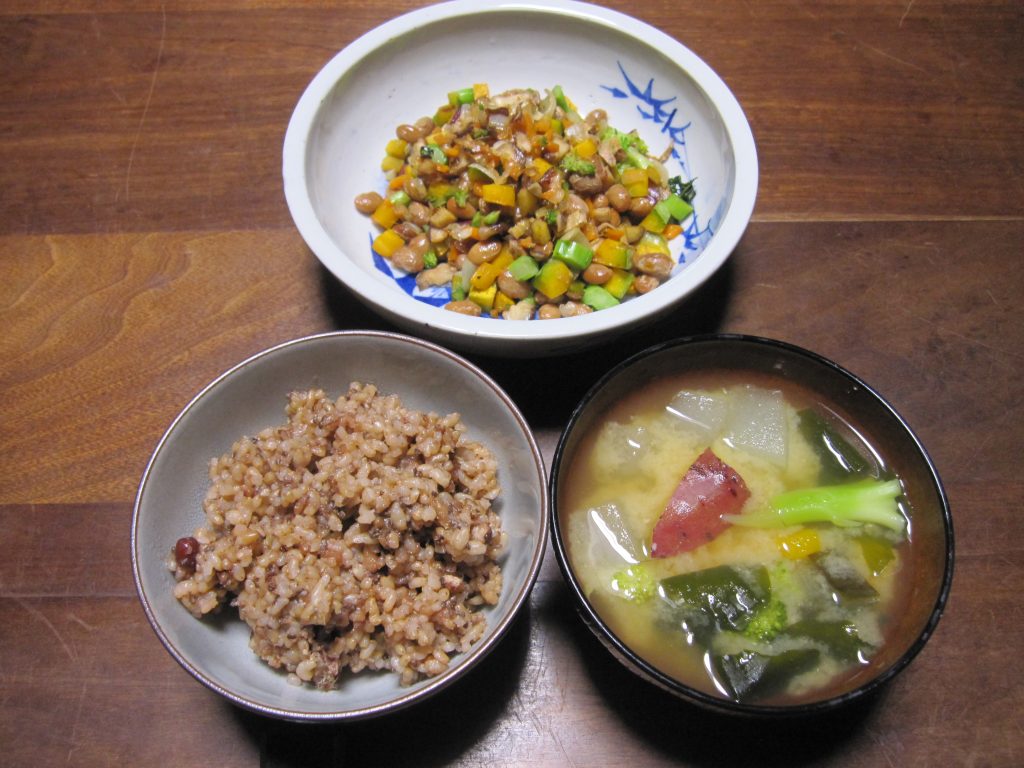As I wrote in yesterday’s post, I had an event called Local Zoom Cafe yesterday and we talked about the macrobiotic diet. The guest I had was a woman who has studied both macrobiotics and Miraishoku Tsubutsubu, which is another popular diet in Japan that I mentioned in Chapter 7 THE SUPERFOOD RICE ALTERNATIVES TO BROWN RICE.
I studied macrobiotics over 30 years ago at the East-West Centre in London, and I stopped practicing it before I returned to Japan. Therefore I don’t know the current situation in the macrobiotic movement in Japan. Yuki, the guest I had yesterday studied at Lima Macrobiotic Cooking School 15 years ago and she is much more familiar with what is happening in the movement today.
Apparently, there are three different schools of teaching within the movement now; Lima style, Kushi style, and Seishoku Kyokai style. Lima style was founded by Lima, the wife of George Ohsawa, the founder of the macrobiotic diet. Kushi style was founded by Michio Kushi, who was a student of George Ohsawa and spread macrobiotics abroad. What I learned in London was Kushi style. I attended the British School of Shiatsu in the East-West Centre where Kushi Institut was also located. Seishoku Kyokai style was founded by another student of George Ohsawa, Shuzo Okada. Each school teaches a slightly different approach.
Yuki can speak for Lima school, but fermented brown rice isn’t recommended so much in the macrobiotic diet. The act of fermenting brown rice makes the rice Yin.
I discovered fermented brown rice since I came back to Japan, not in 1988, much later somewhere around the mid-90s. I had it at a restaurant that served a kind of macrobiotic dishes. Therefore, in the beginning, I thought it was a new trend within the macrobiotic movement. However, recently I have heard people who are rather critical of the macrobiotic diet recommending it, as an alternative to brown rice in macrobiotics. I wasn’t sure since there are several different schools within the macrobiotic movement and there are other diets started by former macrobiotic practitioners.
Now, I know it isn’t recommended by the macrobiotic diet. I suppose Lima school is the most authentic one since it was established by the founder’s wife.
Another thing they don’t value so much is Natto. They eat Natto, but not as much as I do because they regard it to be rather Yin; soybeans, in general, are Yin.
That is interesting. That means the Ikigai Diet is quite different from the macrobiotic diet. I value fermented brown rice and Natto from the viewpoint of bacteria. According to Hitoshi Dozono, the inventor of a popular brown rice liquid called Bannokoboeki, brown rice bacterium is one of the two most powerful bacteria, along with the Natto germ. We can get brown rice bacterium from fermented brown rice and Natto germ from Natto.
I talked about it in Chapter 9 WHEAT VS. RICE THE IKIGAI DIET FOR EUROPEANS
Anyway, it was fun talking about macrobiotics.
Tomorrow, I will share with you what I heard from Yuki about Miraishoku Tsubutsubu.
My Macrobiotic Days and Why I Stopped being Macrobiotic
Why Did I Stop Following the Macrobiotic Diet?
Why Did I Stop Following the Macrobiotic Diet? Part 2
The Ikigai Diet: The Secret Japanese Diet to Health and Longevity
POD Paperback
https://www.amazon.com/gp/product/4991064864
Kindle
